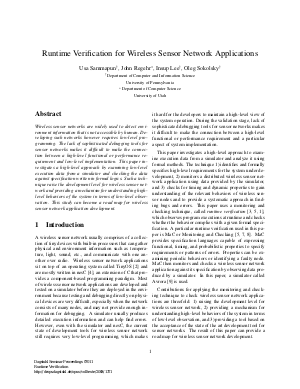Runtime Verification for Wireless Sensor Network Applications
Authors Oleg Sokolsky, Usa Sammapun, John Regehr, Insup Lee
-
Part of:
Volume:
Dagstuhl Seminar Proceedings, Volume 7011
Part of: Series: Dagstuhl Seminar Proceedings (DagSemProc) - License:
 Creative Commons Attribution 4.0 International license
Creative Commons Attribution 4.0 International license
- Publication Date: 2008-02-06
File

PDF
DagSemProc.07011.4.pdf
- Filesize: 211 kB
- 9 pages
Document Identifiers
Subject Classification
Keywords
- Runtime verification
- wireless sensor network
- Avrora simulator
Metrics
- Access Statistics
-
Total Accesses (updated on a weekly basis)
0Document
0Metadata
Abstract
We present a case study that considers the application of runtime verification technology to a wireless sensor application. The case study is performed using the SURGE TinyOS application for multi-hop routing, which executes on the Avrora TinyOS simulator. We discuss the problems we have encountered in the course of case study. The problems include unclear correctness properties for wireless network applications (indicating ad hoc development process) and inadequate tool support. A wireless sensor network usually comprises of a collection of tiny devices with built-in processors that can gather physical and environment information such as temperature, light, sound, etc., and communicate with one another over radio. Many wireless sensor network applications sit on top of an operating system called TinyOS and are mostly written in nesC, an extension of C that provides a component-based programming paradigm. Most of wireless sensor network applications are developed and tested on a simulator before they are deployed in the environment because testing and debugging directly on physical devices are very difficult, especially when the network consists of many nodes, and may not provide enough information for debugging. A simulator usually produces detailed execution information and can help find errors. However, even with the simulator and nesC, the current state of development tools for wireless sensor network still requires very low-level programming, which makes it hard for the developers to maintain a high-level view of the system operation. During the validation stage, lack of sophisticated debugging tools for sensor networks makes it difficult to make the connection between a high-level functional or performance requirement and a particular aspect of system implementation. This paper investigates a high-level approach to examine execution data from a simulator and analyze it using runtime verification. The technique 1) identifies and formally specifies high-level requirements for the system under development, 2) monitors a distributed wireless sensor network application using data provided by the simulator, and 3) checks for timing and dynamic properties to gain understanding of the relevant behaviors of wireless sensor nodes and to provide a systematic approach in finding bugs and errors. A particular runtime verification used inthis paper is MaC. MaC provides specification languages capable of expressing functional, timing, and probabilistic properties to specify requirements or patterns of errors. Properties can, for example, examine periodic behaviors or identify a faulty node. MaC then monitors and checks a wireless sensor network application against its specification by observing data produced by a simulator. The motivation for applying the monitoring and checking technique to check wireless sensor network applications is threefold: 1) raise the development level for wireless sensor network, 2) provide a mechanism for understanding high-level behaviors of the system in terms of low-level observation, and 3) provide a tool based on the acceptance of the state of the art development tool for sensor networks.
Cite As Get BibTex
Oleg Sokolsky, Usa Sammapun, John Regehr, and Insup Lee. Runtime Verification for Wireless Sensor Network Applications. In Runtime Verification. Dagstuhl Seminar Proceedings, Volume 7011, pp. 1-9, Schloss Dagstuhl – Leibniz-Zentrum für Informatik (2008)
https://doi.org/10.4230/DagSemProc.07011.4
BibTex
@InProceedings{sokolsky_et_al:DagSemProc.07011.4,
author = {Sokolsky, Oleg and Sammapun, Usa and Regehr, John and Lee, Insup},
title = {{Runtime Verification for Wireless Sensor Network Applications}},
booktitle = {Runtime Verification},
pages = {1--9},
series = {Dagstuhl Seminar Proceedings (DagSemProc)},
ISSN = {1862-4405},
year = {2008},
volume = {7011},
editor = {Bernd Finkbeiner and Klaus Havelund and Grigore Rosu and Oleg Sokolsky},
publisher = {Schloss Dagstuhl -- Leibniz-Zentrum f{\"u}r Informatik},
address = {Dagstuhl, Germany},
URL = {https://drops.dagstuhl.de/entities/document/10.4230/DagSemProc.07011.4},
URN = {urn:nbn:de:0030-drops-13719},
doi = {10.4230/DagSemProc.07011.4},
annote = {Keywords: Runtime verification, wireless sensor network, Avrora simulator}
}
